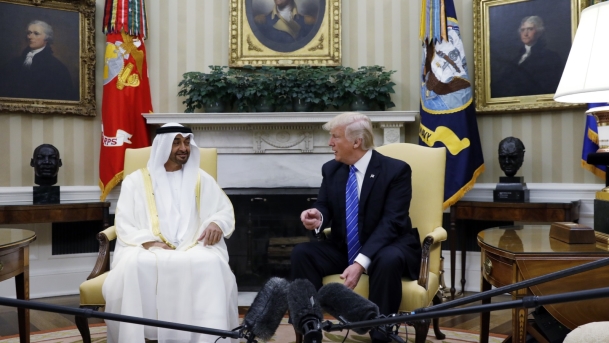
In the 1980s and the 1990s, the United Arab Emirates, led by its founding president, Sheikh Zayed bin Sultan Al Nahyan, followed a centrist policy to international affairs that placed mediation in regional disputes at its heart. Under Sheikh Zayed, who ruled from 1971 until his death in 2004, the UAE followed a foreign policy predicated heavily on close relationships with Gulf and other states in the Arab and Islamic world.(1) Sheikh Zayed emphasised in the early years of the UAE the construction of close friendly relations with the other member states of the Arab League and, after its establishment in 1981, the Gulf Cooperation Council. Thus, in June 1972, Sheikh Zayed stated, in an interview with Al-Amal newspaper, that “the Union is eager to have the same attitude, to be headed in the same direction, and to use the same road as Saudi Arabia.”(2)
Another prominent feature of UAE foreign policy during the formative years of the federation was the commitment to ‘Arabness’ and, in particular, Palestine. Support for Palestine took both political and financial forms. The UAE participated in the Arab oil embargo between October 1973 and March 1974 (although Dubai only joined the embargo three days after Abu Dhabi), cut exports to the United States and the Netherlands in retaliation for their support of Israel during the Yom Kippur War, and provided the ‘front-line states’ in the Arab-Israeli conflict with wide-ranging support. UAE-based donors also made very considerable charitable donations and pledges of aid and development to Palestine, with Abdul-Monem al-Mashat estimating that more than US$20 billion was provided in the 1970s and 1980s. Once again, UAE actions were consistent with broader regional trends as other Gulf States during the same period also channelled foreign aid donations to ‘front-line states’.(3)
Increased Security Engagement
Major changes to UAE foreign policy began in the late 1990s, as Sheikh Zayed aged, and as the UAE moved gradually away from the focus on Arab and Islamic issues and engaged proactively with key developments in the global economy and international governance to accumulate substantial reserves of ‘soft’ and ‘hard’ power and carve out niches in selected economic sectors such as aviation, renewable energy and international finance. Relations with the United States deepened, particularly after the shock of 11 September 2001 attacks which included two Emiratis among the nineteen hijackers, and remain a cornerstone of UAE foreign policy. As such, the UAE has participated militarily alongside US forces in every Middle Eastern conflict since the Gulf War of 1991 with the sole exception of the 2003 US-led invasion of Iraq.(4)
UAE involvement in Afghanistan since 2001, illustrates the evolution in the country’s approach toward international affairs and the combination of elements of ‘hard’ and ‘soft’ power projection. Along with Saudi Arabia and Pakistan, the UAE had been one of only three countries that had recognised the Taliban regime after it took over in 1996. After the fall of the Taliban, the UAE quickly threw its support behind the government of Hamid Karzai that came to power in December 2001. Members of the UAE Armed Forces were stationed in Afghanistan between 2001 and 2014 and, as the only military force from an Arab country, engaged heavily in humanitarian work, such as aid and medical services, in addition to combat support for US and NATO forces. UAE military operations in Afghanistan operated in parallel with a humanitarian approach that emphasised how safety and stability were essential prerequisites for successful aid and development.(5)
A shift in the centres of decision-making
Over the past decade, the UAE increasingly has become a contributor to, rather than merely a consumer of, regional security structures not only in the Gulf but also in the broader Middle East region. Indeed, seen in retrospect, the scope and scale of the UAE’s military contribution to the Afghanistan operations anticipated its involvement alongside another NATO-led venture – Operation Unified Protector – in Libya between March and October 2011, and, on a regional level, its contribution to the GCC Peninsula Shield Force intervention in Bahrain in March 2011 and, on a far greater scale, to the Saudi-led Arab coalition that commenced military operations in Yemen on 26 March 2015 as part of Operation Decisive Storm. All of these examples illustrated the growing assertiveness in UAE foreign policy as a security ‘clique’ clustered around the Crown Prince of Abu Dhabi, Sheikh Mohammed bin Zayed Al Nahyan, asserted policymaking control.(6)
Two power shifts have occurred in recent years that have impacted significantly on regional and foreign policymaking in the UAE. There has been a shift in influence within the seven-emirate federation away from Dubai to Abu Dhabi and from the nominal Ruler of Abu Dhabi and President of the UAE, Sheikh Khalifa bin Zayed Al Nahyan, to Sheikh Mohammed bin Zayed. Sheikh Khalifa has not been seen since he suffered a stroke in January 2014 and it is unlikely that he will ever make any significant reappearance in public life. Even though Mohammed bin Zayed has been the real ‘power behind the throne’ in Abu Dhabi for several years, until 2015 he trod carefully on the federal stage, mindful of the need to avoid unbalancing dynamics within the Al Nahyan family and inter-emirate relations with Dubai. These constraints have been shed over the past two years as Mohammed bin Zayed has put members of his immediate family and other close allies in key economic and security positions across Abu Dhabi.(7)
A partnership of the rigid
The central axis within the GCC now runs through Mohammed bin Zayed in Abu Dhabi and Deputy Crown Prince Mohammed bin Salman in Saudi Arabia. A close working relationship has developed between the two men, who share a ‘can-do’ mentality that favours ambitious ‘big-picture’ approaches to national and regional issues. This new partnership has been most visible in Yemen and has survived the inherent policy contradictions whereby Yemen has effectively been carved into separate Saudi and Emirati spheres of influence. Most significantly, for Qatar, Mohammed bin Zayed has secured Saudi backing for his hard-line approach to the Muslim Brotherhood and other regional Islamist groups. Saudi Arabia joined the UAE in designating the Muslim Brotherhood a terrorist organisation in March 2014, the last time that both countries’ diplomatic ties with Qatar were ruptured. Although King Salman pragmatically engaged with members of the Brotherhood after he came to power in January 2015, the Saudi stance has once again moved closer to the Emirati one in recent months.(8)
This leaves Qatar in an extremely delicate position, as evidenced by the orchestrated media offensive from Saudi and Emirati outlets that erupted in late May 2017 and the coordinated cutting of diplomatic relations and imposition of economic sanctions on Qatar on 5 June. Both the UAE and Saudi Arabia appear to have calculated that the foreign policy inexperience of the Donald Trump presidency presents an opportunity to shape administration thinking on key issues. Close personal relations have developed between Saudi and Emirati leaders and President Trump’s son-in-law and senior advisor, Jared Kushner, and prominent members of the administration, such as Secretary of Defence James Mattis and CIA Director Mike Pompeo, hold positions on Iran and the Muslim Brotherhood that are virtually indistinguishable from Riyadh or Abu Dhabi.(9) And yet, while Emirati and Saudi leaders felt emboldened by President Trump’s Riyadh Summit to move rapidly against Qatar, Kuwait and Oman noticeably have not followed suit. The result of this latest diplomatic standoff with Qatar is likely to magnify still further the divisions between the inner and outer core of the GCC and conceivably lead to one or more member states leaving the group.
(1) Vania Carvalho Pinto, “From “Follower” to “Role Model”: the Transformation to the UAE’s International Self-Image,” Journal of Arabian Studies, 4(2), 2014, p.234.
(2) Abdulkhaleq Abdulla, “New Assertiveness in UAE Foreign Policy,” Gulf News, 9 October 2012.
(3) Abdul-Monem al-Mashat, “Politics of Constructive Engagement: The Foreign Policy of the United Arab Emirates,” in Bahgat Korany and Ali Hillal Dessouki (eds.), The Foreign Policies of Arab States: The Challenge of Globalization (Cairo: American University of Cairo Press, 2008), p.472).
(4) Rajiv Chandrasekaran, “In the UAE, the United States has a Quiet, Potent Ally Nicknamed ‘Little Sparta’,” Washington Post, 9 November 2014.
(5) Mission: Winds of Goodness, “Our Partners who Helped and Supported the Project,” available online at http://www.uaeafghanistan.ae/en/Brand-of-Abu-Dhabi.php.
(6) Kristian Coates Ulrichsen, “The UAE’s Evolving Power Dynamics,” Houston Chronicle/Baker Institute Blog, 1 March 2016.
(8) David Hearst, “Three Potential Moves Behind the Tension between Qatar and its Gulf Neighbors,” Middle East Eye, 2 June 2017.
(9) Kristian Coates Ulrichsen, “US Policies in the Middle East Under the Trump Presidency,” Orient XXI, 18 April 2017.
